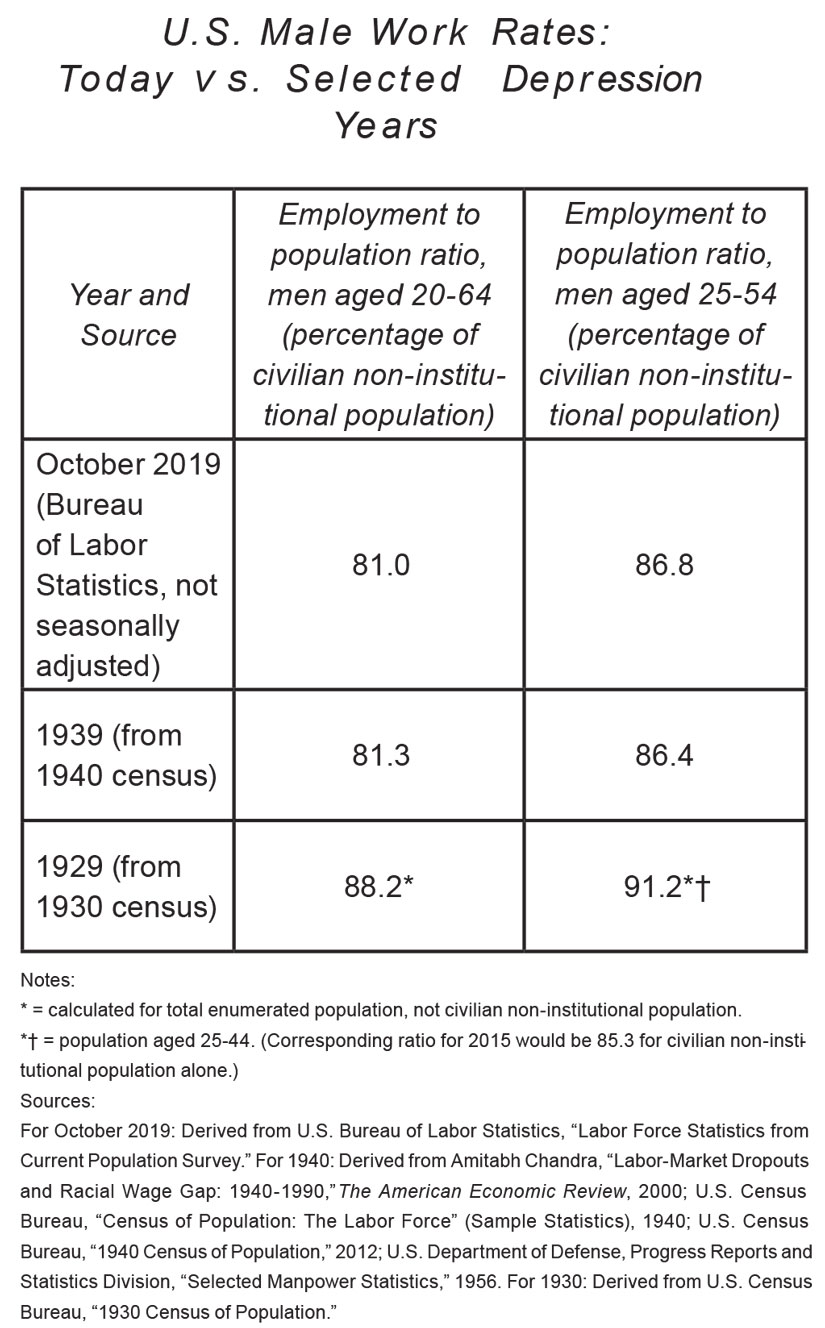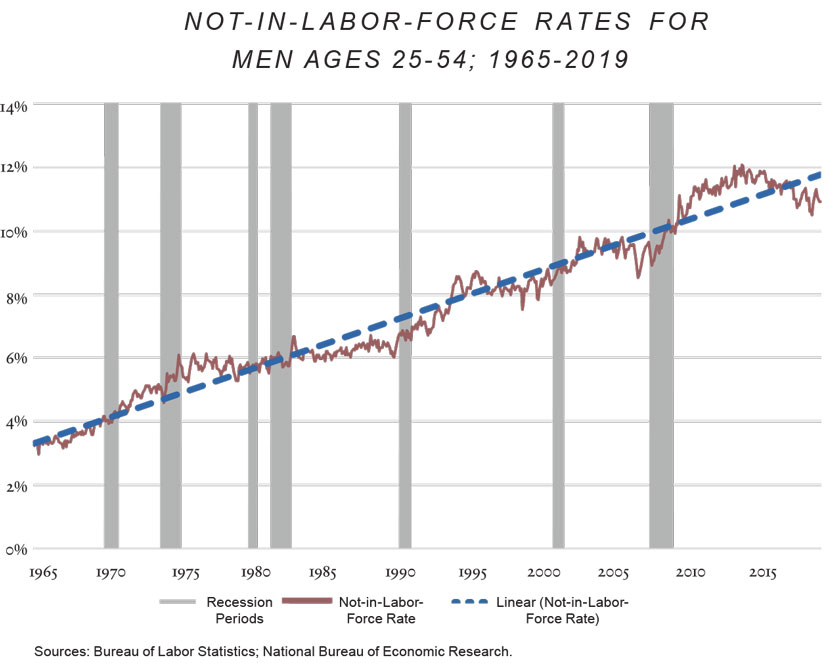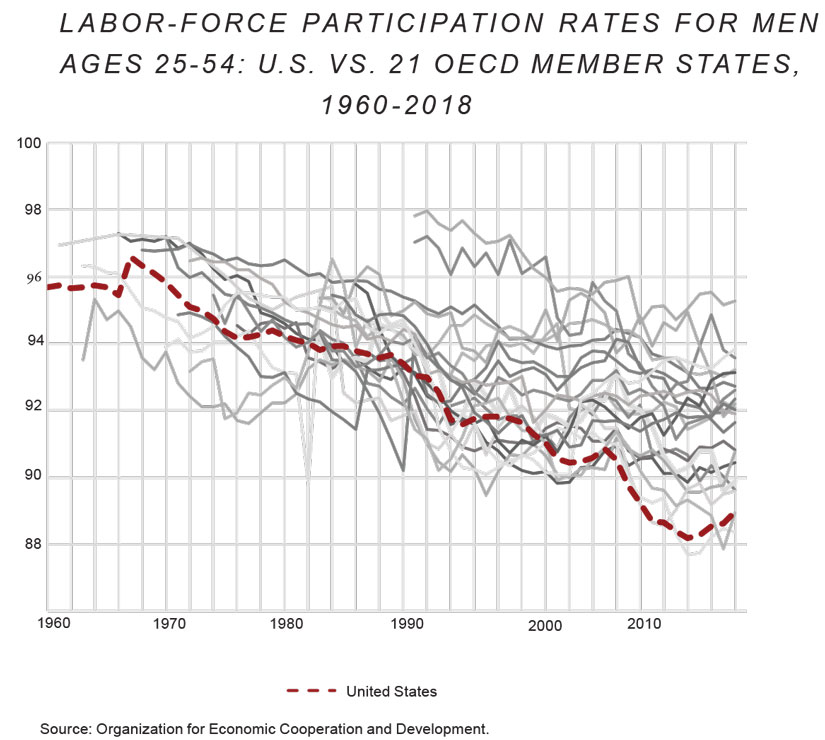Education and Men without Work
America today is in the grip of a gradually building crisis that, despite its manifest importance, somehow managed to remain more or less invisible for decades — at least, until the political earthquake of 2016. That crisis is the collapse of work for adult men, and the retreat from the world of work of growing numbers of men of conventional working age.
According to the latest monthly jobs report from the Bureau of Labor Statistics, "work rates" for American men in October 2019 stood very close to their 1939 levels, as reported in the 1940 U.S. Census. Despite some improvement since the end of the Great Recession, Great Depression-style work rates are still characteristic today for the American male, both for those of "prime working age" (defined as ages 25 to 54) and for the broader 20 to 64 group.
Unlike the Great Depression, however, today's work crisis is not an unemployment crisis. Only a tiny fraction of workless American men nowadays are actually looking for employment. Instead we have witnessed a mass exodus of men from the workforce altogether. At this writing, nearly 7 million civilian non-institutionalized men between the ages of 25 and 54 are neither working nor looking for work — over four times as many as are formally unemployed. Between 1965 and 2015, the percentage of prime-age U.S. men not in the labor force shot up from 3.3% to 11.7%. (The overall situation has slightly improved in the last four years, but this group still accounted for 10.8% of the prime-age male population in October 2019.) Over that half century, labor-force participation rates fell for prime-age men in all education groups, but the decline was much worse for men with lower levels of educational attainment than for those with higher levels. Labor-force participation dropped by about four percentage points for college graduates and by two points for men with graduate training; it fell by 14 points for those with no more than a high-school diploma, and by 16 points for those who didn't finish high school. By 2015, nearly one in six prime-age men with just a high-school degree was neither working nor looking for work, and for those without a high-school diploma, the ratio was worse than one in five.

Among economists and policy analysts who have examined these unsettling trends, the general consensus is that declining male workforce participation in modern America is mainly a structural, demand-driven problem — a matter of evaporating local jobs, and especially jobs requiring limited skills, in an increasingly dynamic and globalized marketplace. Exemplifying this received wisdom is the Council of Economic Advisers' 2016 report on declining male labor-force participation rates. As that study put it,
The fall in participation for prime-age men has largely been concentrated among those with a high school degree or less....Reductions in labor supply — in other words, prime-age men choosing not to work for a given set of labor market conditions — explain relatively little of the long-run trend....In contrast, reductions in the demand for labor, especially for lower-skilled men, appear to be an important component of the decline in prime-age male labor-force participation.
If this assessment is more or less correct, it would be hard to overstate the importance of education and training as instruments for addressing our "men without work" crisis. If our rapidly modernizing economy is displacing those with limited education and skills, redoubled efforts to improve the quality of our education system, to increase our population's educational attainment, and to improve the training of those already in the workforce would seem imperative to forestall further deterioration in the male employment profile, let alone turn these trends around.
But what if this assessment is not correct? If the diagnosis offered by today's conventional wisdom is wrong, then the prescription — more and better schooling — is unlikely to solve the problem by itself. There can be no arguing against more and better education for America, of course; more and better education appeals on its own merits, as it offers our society and its citizens all sorts of incontestable benefits. But as an instrument for redressing the long-term "flight from work" by men in modern America, more and better education may prove to be of more limited utility than many of us might hope.
This is not to deny the important role of structural economic change in America's current labor-market troubles, especially for those with limited education and skills. But the standard "demand-side" explanation of these travails is manifestly incapable of accounting for a number of critical aspects of the ongoing decline of work for men in modern America.
SUPPLY AND DEMAND
Four key facts about declining male labor-force participation in the U.S. demonstrate that the prevailing "demand-side" narrative about the problem needs to be revised and qualified — perhaps significantly qualified.
First, there is the uncanny regularity of the prime-age American male's long march out of the labor force since the 1960s. As may be seen in the figure below, U.S. prime-age male "inactivity rates" (or not-in-labor-force rates) have been rising at a remarkably steady tempo since the mid-1960s. This monthly exodus from the workforce has been so steady since 1965 that it almost traces a straight line. (With an r-squared of 0.96, we might even be tempted to call this a "social-sciences straight line," considering how unruly observed social patterns for collections of human beings tend to be.)

The tempo of workforce withdrawal appears to be almost completely unaffected by the tempo of national economic growth, which varied appreciably over this period. Even recessions — including the Great Recession — appear to have scarcely any impact on the trend. Likewise, the NAFTA agreement, China's entry into the World Trade Organization, and other "disruptive" trade events with major implications for the demand for labor in America do not stand out in this chart. The striking steadiness of this exodus, year in and year out, is fundamentally inconsistent with a demand-side explanation for declining labor-force participation rates.
Second, there is the pronounced and increasing disparity in labor-force participation rates among different sub-regions of the country. Modern America has witnessed increasing dispersion in state-level prime-age male labor-force participation rates since at least 1980. Moreover, major, enduring, and sometimes even widening gaps in prime-age male labor-force participation rates are evident for geographically adjoining states (compare, for example, Maine to New Hampshire, or West Virginia to Virginia or Maryland). If declining participation rates were a consequence of demand shocks to the labor force, economic theory would suggest the national labor market would move toward equilibrium over time, implying, among other things, eventual convergence in participation rates among states. Just the opposite, however, has been taking place in America for most of the period in which the decline in male labor-force participation rates has been underway.
Third, there is America's curiously poor prime-age male labor-force participation-rate performance in comparison with other affluent never-communist democracies. Between 1965 and 2015, U.S. levels fell faster and sank lower than in any comparable country, with the exception of Italy (where official employment figures notoriously neglect "unofficial" work income). Yet America's race to the bottom in prime-age male labor-force participation is not readily explained by lackluster economic growth (which could also be called sluggish demand). It is true that the U.S. is believed to have grown more slowly than most of these countries over that half century, but this should be unsurprising given that most of these countries were enjoying "latecomer" or catch-up growth over this period in relation to the longtime U.S. "frontrunner." Even so, U.S. labor-force participation-rate trends were also distinctly poorer than those of countries whose pace of growth lagged behind America's over that half century: for example, Denmark and Sweden, to say nothing of Greece.
Nor would the United States seem an especially likely candidate for a massive shedding of jobs due to the displacement of less-educated workers, for the simple reason that the U.S. workforce has always had one of the OECD's very highest educational-attainment profiles. Indeed, of all the countries covered by Robert Barro and Jong-Wha Lee's Educational Attainment Dataset, only Switzerland had a (very slightly) higher level of mean years of schooling than the United States for its prime-age male population as of 2010, the most recent year offered for such calculations. To be sure, for individuals and nations alike, years in school is an imperfect measure of true skills and knowledge. It is well known that public K-12 education in the United States is mediocre — a fact confirmed inter alia by international student-testing efforts, such as the OECD's Programme for International Student Assessment (better known as PISA). But "mediocre" means in the middle — not at the bottom. International knowledge and skills tests for working-age adults from the OECD's Programme for the International Assessment of Adult Competencies (PIAAC) showed that as of 2017, the U.S. looked about average against OECD peers in "problem solving in technology-rich environments"; America was a little better than most in literacy, a little worse in numeracy. On their face, such results can hardly explain our bottom-of-the-barrel performance in OECD trends in prime-age male labor-force participation.

Fourth, and by no means least important, dramatic differences in prime-age male labor-force participation rates exist within the less-educated segment of that population, indicating that low labor-force participation is actually not a necessary fact of life today for American men with limited education. As I have demonstrated in other work, a gap of roughly 25 percentage points separated the labor-force participation rates of foreign-born and native-born prime-age male high-school dropouts in 2015. Elsewhere I have shown that the gap in labor-force participation rates between married and never-married prime-age male high-school dropouts was on the order of 20 percentage points as of 2015. If we go further and parse participation rates by marital status and "nativity status" at the same time, even more radical differences emerge.

As of 2018, the U.S. prime-age male labor-force participation rate for foreign-born high-school dropouts was 93% — all but identical to the national level for prime-age males with college degrees. Rates that year for never-married immigrants without high-school degrees were lower (88%) — but nonetheless comparable to the national level for prime-age men with some college training. Married native-born prime-age male high-school dropouts had distinctly lower labor-force participation rates than immigrants (78%), although it is worth noting such performance put them roughly on par with America's prime-age men who held high-school degrees but had never married.
On the other hand, labor-force participation rates for native-born, never-married prime-age male high-school dropouts are in an abysmal class all of their own: Their rates nowadays hover just above the 50% mark, meaning they are not only close to 25 points below those of married native-born high-school dropouts, and well over 30 points lower than for never-married foreign-born high-school dropouts, but also nearly 40 points lower than for married foreign-born high-school dropouts.
Needless to say, such enormous discrepancies in labor-force participation rates for persons in the same category of educational attainment are not what one would expect to observe if "demand-side" forces were actually the determinative factor in these labor-market outcomes. Or, to put the matter a little more precisely, while some measure of disparity in labor-market outcomes might be expected within this demographic and education grouping — the selection effects of migration and assortative mating surely play some role — it would be absurd to propose (as a demand-effects model must) that the extraordinary disparities in labor-force participation rates seen in the figure above faithfully reflect true underlying differences in knowledge and skills, much less the sorts of knowledge and skills that academic training can impart.
WORK-FREE LIFESTYLES
What economists call "demand-side effects" cannot plausibly account for America's overall men-without-work predicament — and might not even account for most of it. While more education may always be better than less, we cannot expect more education to solve a problem that a lack of education did not cause, and it is clear that male worklessness is due to much more than just a shortage of skills and training. We can discern a more realistic role for education if we consider other dimensions of the crisis: what economists would call the "supply-side effects" and "institutional effects." In this taxonomy, the more relevant pieces of the puzzle are family structure, government-benefit dependence, and mass incarceration and felonization.
To start, although discussion of family structure and its consequences is held to be in poor taste or even off-limits completely in some academic and political circles these days, the strong relationship between family structure and employment status for men is undeniable. Simply stated, family structure is a powerful predictor of male labor-force participation rates (among other things). Overall, labor-force participation rates in 2018 were 10 percentage points lower for never-married prime-age men than for their currently married counterparts — and the discrepancy in work rates was greater still. Even after controlling for age, ethnicity, and education, married men are decidedly more likely to be in the workforce than men who have never married. This "marriage effect" is so powerful that married prime-age male high-school dropouts generate labor-force participation rates in the same league as their never-married, college-graduate peers. Analogous but somewhat less powerful effects are seen when we drill deeper into family life: Irrespective of marital status, education, and ethnicity, a prime-age man is more likely to be in the workforce if he lives in the same home as children under the age of 18, regardless of his race or education.
Unfortunately, American family structure has been transformed over the past generation, and in ways that incontrovertibly created severe downward pressure on prime-age male labor-force participation rates. In 1965, 85% of prime-age men were married; by 2015, that share had dropped by nearly 30 percentage points. By the same token, whereas only a relatively small minority of prime-age men (29%) lived in homes without children in 1968 (the first year the survey used in the BLS monthly jobs report asked this question), by 2015 an outright majority of prime-age men (54%) lived in childless homes. Needless to say, the relationship between family structure and prime-age male labor-force participation is complex, with causation arrows pointing both ways. Yet on balance, the net effect of such changes appears to have been a withdrawal of male labor from the workforce — a "supply-side effect," and a major one.
The order of magnitude is suggested by an illustrative calculation. Holding year 2015 probabilities of prime-age male labor-force participation constant, but applying year 1965 distributions of marital status among prime-age males against these, would give us conditional prime-age male labor-force participation rates six percentage points above the reported 2015 level. (By way of contrast, the actual prime-age male labor-force participation rate fell 8.4 percentage points over that half century.) Our illustrative calculations provide nothing more than a crude first impression, but they nevertheless suggest that changes in family structure had a powerful and adverse impact on male work rates and labor-force participation rates, irrespective of ethnic and other demographic changes over those two generations.
Lest it go unsaid: The collapse of work for men in modern America is much more closely associated with family structure than race. Yes, shifts in population composition by race and ethnicity have been substantial since the 1960s and early 1970s. But these played a very small net role in depressing male labor-force participation rates. While prime-age male African-Americans had consistently lower work and labor-force participation rates than Anglos, Latino and Asian rates remain comparable to (and sometimes superior to) those for non-Hispanic whites — and since Latinos and Asian-Americans are America's fastest growing populations, the net impact of ethnic change per se on male employment profiles has been negligible. This is clear from employment data since 1971, when the Census Bureau started tracking labor-force participation of Hispanics, non-Hispanic whites, and non-Hispanic blacks. Between 1971 and 2015, U.S. prime-age male workforce participation rates dropped by 7.2 percentage points. Yet applying 1971 ethnic weightings against 2015 participation rates by ethnicity would result in no change at all in overall prime-age male labor-force participation rates — and conducting the corresponding exercise for work rates offers a calculated result just 0.1 percentage point lower than the 2015 rate actually recorded. The declining share of Anglos in the prime-age male population, in other words, seems to have had scarcely any net impact on labor-force participation rates — but the same cannot be said about the sharp fall in the share of married Anglos.
The second factor contributing to worklessness that must be considered is dependence on government benefit programs — including disability programs intended to provide income, goods, and services to working-age men and women who are prevented from working or seeking work due to physical or mental impairment. The U.S. government has a multiplicity of such programs. Though they were designed as social-insurance platforms, evidence suggests they are increasingly used as income-support mechanisms for men on a work-free life track. (Current data suggest that most men who are not in the labor force have dropped out for the long term, at least one year and perhaps much longer.)
Due to the haphazard and disjointed nature of government benefit information, there is no single source of data to show exactly how many prime-age men are obtaining one or more disability benefit from government at the federal, state, and local levels. Even so, as of 2013 it was clear that a majority of prime-age men not in the labor force received direct payments from at least one of the three major federal disability programs, and roughly two-thirds lived in households obtaining at least one disability benefit — substantially higher fractions than in the 1980s. Disability benefits are never lavish, but, together with eligibility for additional benefits unlocked by disability enrollment and with resources from family and friends, they can and clearly do provide the basis for a viable work-free existence for many millions of prime-working-age men today.
That dependence on government benefits is another supply-side factor in the men-without-work crisis — this one still curiously under-examined by academics and policy analysts. Available information, however, points to a number of troubling features about the world of prime-age male disability and non-work. Apart from the small fraction (around 13% in 2015) of prime-age male non-workers who are adult students, the remainder report spending many of their waking hours watching and playing on screens — over 2,000 hours per year on average. Almost half of these non-working men report taking pain medication on any given day (which should raise a red flag for those worried about the opioid crisis). And when we stratify by educational attainment, we find that around three-quarters of prime-age non-working men without a high-school diploma are reporting disability benefits, while over four-fifths report access to government health-program support.
These facts taken together would perhaps be unexceptionable if we did not already know, thanks to journalist Sam Quinones and others, that the Medicaid and Medicare programs have been widely abused for opioid consumption. All these varied strands come together to form a web of supply-side factors that may keep many out of the labor force, even when their education qualifications or test scores should, according to the demand-side narrative, allow them to function in it.
CRIMINAL JUSTICE
Beyond these supply-side factors, there are "institutional effects," or structural barriers to entry into the workforce. And when we think about our men-without-work problem and contributing institutional effects, we cannot miss the distinctive new American phenomena of mass incarceration and mass felonization.
Many Americans are generally aware of the notorious scale of mass incarceration today — with almost 2.3 million people behind bars, America incarcerates a larger share of its population than virtually any other country on earth. But the vast dimensions of mass felonization are little known to the public, mainly because, scandalously, the U.S. government simply does not collect data on this demographic characteristic of the national population. One signal study attempting to reconstruct the stock and flow of the U.S. felon population, however, estimated that, as of 2010, nearly 20 million adults in America had been convicted of at least one felony. A little bit of arithmetic would suggest that the current U.S. felon and ex-felon population is now on the order of 24 million — meaning that well over 20 million felons and ex-felons today are not behind bars. Since sentenced criminals are disproportionately male, this means that over one in eight adult men in the civilian non-institutional population (the pool from which labor-force statistics are drawn) has a felony in his background — and the ratio for prime-age men today is most likely even higher than this.
Preliminary research suggests that irrespective of age, ethnicity, and educational attainment, men who have been to prison are much more likely to be out of the labor force than those who "only" have an arrest record; likewise, men who have an arrest in their background are more likely to be out of the labor force than those who have never had trouble with the law. That said, the odds of felonization are far higher for black men than for others, and far higher in every ethnic group at the lowest levels of educational attainment. Work by sociologists Bruce Western and Becky Pettit on criminal-justice trends for men born between 1957 and 1964 showed that about three-fifths of black male high-school dropouts, and about one-fifth of their white counterparts, had been incarcerated at least once by their mid-30s. It is probable that those ratios are even higher today. And the proportion of prime-age males with arrest records will be higher still. According to a study by the Bureau of Justice Statistics, as of 2016, about 110 million American adults — or about 45% of the adult population — had arrest records.
The "felonization effect" in reducing post-war prime-age male labor-force participation rates has not yet been calculated, but it is clearly significant in quantitative terms. Also to be determined is the precise role of education (or the lack of it) in these dismal statistics and the mechanisms at work. Is education merely serving as a class marker, or do skills and knowledge have independent influence on these outcomes? If so, how much? What roles are cognitive effects and discrimination playing?
Untangling these and other inter-related factors — including family breakdown and growing government benefit dependence — will be essential to reaching a better understanding of the education system's role in getting us into the men-without-work crisis, and its potential role in getting us out of it.
SUPPLY-SIDE SOLUTIONS
If the men-without-work crisis in America actually comported with the description of it in much of the economics and policy literature — that is to say, if it were basically a demand-side problem — then the task for the U.S. education system (broadly construed) would be fairly straightforward and in a sense comparatively easy. The education system would "only" have to provide the needed but missing training and skills to rising generations of youth and existing generations of working adults in order to rescue them from occupations, fields, industries, and sectors that were dying due to lack of demand.
But as our post-Great Recession economic expansion completes its 10th full year and moves into its 11th, the dissonance between the demand-side narrative and actual conditions on the ground is increasingly jarring. In America today, we have at the same time both an incipient labor shortage and Depression-style work rates for men. The BLS Job Openings and Labor Turnover Survey (JOLTS) for September 2019 reported 7 million unfilled positions in the U.S. workforce. And at this writing, there are roughly 1.7 million prime-age male high-school dropouts and 3.6 million prime-age men with just high-school degrees in America who are neither working nor looking for work.
While many jobs in the modern economy require a college education or advanced degree, not all the open job slots in the JOLTS survey are for computer coders or chemical engineers. To the contrary, more than 800,000 of these unfilled positions are in "accommodation and food services"; almost three-quarters of a million are in "retail trade"; and more than 300,000 are in construction. Whether or not one happens to regard such work as attractive or sufficiently remunerative, the fact of the matter is that most of these positions do not require any higher education, and a great many do not even require a high-school diploma. Recent reporting has put a human face on the paradox of a country awash in low-skill jobs at a time when millions of men with high-school diplomas or less are out of the workforce. In these accounts, positions go unfilled because of a lack of interest by non-workers, or because of unreliable applicants who do not show up for work regularly and on time, or because applicants cannot stay sober or pass drug-screening tests.
These are devilishly difficult problems, rooted in far more than a lack of skills, and it seems unreasonable to expect the U.S. education system to fix such joblessness, or even make an appreciable difference. Yet we expect just that because, at a time when so many other institutions in civil society are in disarray or retreat, the school system is not only still standing, but still largely trusted and respected. As other institutions of civil society fail or fade, educators and trainers are loaded down with ever more responsibilities and assignments previously undertaken by others. Teachers must be not only teachers, but surrogate parents, secular confessors, makeshift therapists, boot-camp drill instructors, financial advisers, de facto cops on the beat, even truant officers or dress-rehearsal probation officers. Little wonder they cannot accomplish all these missions — much less the more modest but hardly trivial duty of inculcating academic excellence.
In the face of today's often-distressing realities, there are some avenues that hold promise (albeit limited) for the men-without-work problem. Improving the quality of public K-12 education is obviously vital — especially in neighborhoods where schools are mediocre or worse. That, of course, should be a top priority of all educators already, as it has been for champions of education reform for many decades, and there are many paths and strategies for effecting such improvements.
But the virtues of vocational training have gone widely underappreciated — by policymakers, educators, and parents as well — for at least half a century, as the male worklessness problem has gradually worsened. Guidance counselors' narrow focus on college does not serve all students well. College is not for everyone — but everyone should graduate with a skill. High schools should be capable of equipping students with some of these skills.
Improving training for the working (and non-working) adult population must also be a high-priority objective, but of course this is easier said than done. "Life-long learning" has been little more than a slogan for the past generation. Serious consideration must be given to the many different possible avenues and methods for advancing this goal. Our federal system would seem well-situated to offer a laboratory for local experimentation in this realm, and there are real challenges to work through: Reaching workers is one thing; reaching non-workers is something else again. Among non-workers, the unemployed may generally be easier to reach and train than those not in the labor force, precisely because the former by definition want jobs. Reaching those who have dropped out of the labor force completely may require major and systematic changes in the way we deal with other public-policy issues, such as welfare programs, sentencing, and re-entry. We may want to consider, for example, whether our disability programs could be entirely overhauled under a "work-first" precept, with an emphasis on training and skills for those who could indeed function in the workforce. And we may want to think about the potential for skills training under different auspices and modalities for ex-offenders, to help them address the challenge of finding employment while repairing their reputations.
In these and other ways, the U.S. education system might make inroads against the men-without-work crisis. These policy interventions might have positive effects, but we would do well not to over-promise benefits and results. The men-without-work crisis in America today is in large measure a consequence of long-term historical transformations in American society. More schooling will not repair the family or the other institutions that formed the foundation for male work in America until very recently. For that we may need to await the next Great American Awakening.

